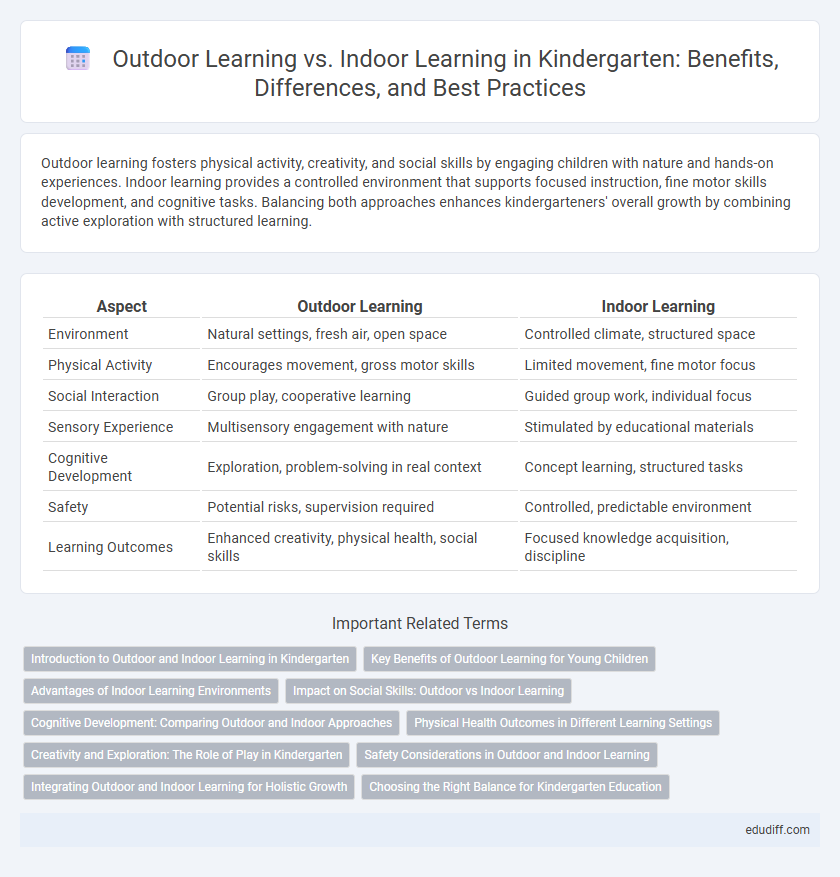Outdoor learning fosters physical activity, creativity, and social skills by engaging children with nature and hands-on experiences. Indoor learning provides a controlled environment that supports focused instruction, fine motor skills development, and cognitive tasks. Balancing both approaches enhances kindergarteners' overall growth by combining active exploration with structured learning.
Table of Comparison
| Aspect | Outdoor Learning | Indoor Learning |
|---|---|---|
| Environment | Natural settings, fresh air, open space | Controlled climate, structured space |
| Physical Activity | Encourages movement, gross motor skills | Limited movement, fine motor focus |
| Social Interaction | Group play, cooperative learning | Guided group work, individual focus |
| Sensory Experience | Multisensory engagement with nature | Stimulated by educational materials |
| Cognitive Development | Exploration, problem-solving in real context | Concept learning, structured tasks |
| Safety | Potential risks, supervision required | Controlled, predictable environment |
| Learning Outcomes | Enhanced creativity, physical health, social skills | Focused knowledge acquisition, discipline |
Introduction to Outdoor and Indoor Learning in Kindergarten
Outdoor learning in kindergarten promotes sensory engagement and physical activity through nature exploration, enhancing cognitive development and social skills. Indoor learning provides a structured environment focused on foundational academic skills, fine motor development, and imaginative play with educational materials. Balancing both settings supports holistic growth, catering to varied learning styles and promoting adaptability in young children.
Key Benefits of Outdoor Learning for Young Children
Outdoor learning in kindergarten enhances sensory development, physical health, and environmental awareness by engaging children in natural settings. It fosters social skills and creativity through unstructured play and hands-on exploration, leading to improved cognitive abilities. Exposure to fresh air and natural light also boosts mood and concentration, supporting overall well-being and academic readiness.
Advantages of Indoor Learning Environments
Indoor learning environments in kindergarten offer controlled settings that enhance concentration, reduce distractions, and provide access to a variety of educational resources such as books, manipulatives, and technology. These spaces ensure safety and comfort, enabling consistent learning regardless of weather conditions. Moreover, indoor classrooms facilitate structured activities that promote social interaction, fine motor skill development, and individualized instruction.
Impact on Social Skills: Outdoor vs Indoor Learning
Outdoor learning environments encourage collaborative play and communication among kindergarten children, fostering essential social skills like cooperation, empathy, and conflict resolution. Indoor learning settings provide structured activities that promote focused group interactions and turn-taking, supporting the development of attentive listening and verbal expression. Balancing outdoor and indoor learning experiences enhances overall social competence by combining free-form socialization with guided interpersonal interactions.
Cognitive Development: Comparing Outdoor and Indoor Approaches
Outdoor learning in kindergarten enhances cognitive development by stimulating sensory experiences and promoting problem-solving skills through direct interaction with nature. Indoor learning provides structured environments that support focused attention and the acquisition of foundational knowledge using educational materials and technology. Combining both approaches fosters well-rounded cognitive growth by balancing experiential learning with academic skill-building.
Physical Health Outcomes in Different Learning Settings
Outdoor learning in kindergarten significantly enhances physical health outcomes by promoting increased physical activity, motor skills development, and exposure to natural sunlight, which supports vitamin D synthesis. In contrast, indoor learning environments often limit movement and reduce opportunities for active play, potentially contributing to sedentary behaviors and associated health risks. Integrating outdoor activities into early childhood education fosters holistic physical development and helps prevent childhood obesity and related health issues.
Creativity and Exploration: The Role of Play in Kindergarten
Outdoor learning in kindergarten enhances creativity and exploration by providing diverse sensory experiences and natural materials that stimulate imaginative play. Indoor learning offers structured environments with educational toys and tools that support fine motor skills and focused creative tasks. Both settings play crucial roles in nurturing children's cognitive development and fostering a love for discovery through play.
Safety Considerations in Outdoor and Indoor Learning
Safety considerations in kindergarten outdoor learning include secure fencing, weather-appropriate clothing, and constant supervision to prevent accidents and exposure to extreme elements. Indoor learning requires childproofed spaces, non-toxic materials, and clear evacuation routes to minimize hazards like falls or allergic reactions. Both environments demand regular safety audits and staff training to ensure a secure and healthy learning experience for young children.
Integrating Outdoor and Indoor Learning for Holistic Growth
Integrating outdoor and indoor learning in kindergarten fosters holistic growth by engaging multiple senses and promoting cognitive, social, and physical development. Outdoor learning encourages exploration, creativity, and hands-on experiences, while indoor settings support structured activities and focused skill-building. Combining these environments creates a balanced curriculum that nurtures curiosity, motor skills, and emotional intelligence in young children.
Choosing the Right Balance for Kindergarten Education
Outdoor learning in kindergarten enhances sensory development, motor skills, and environmental awareness, promoting experiential and active engagement with nature. Indoor learning complements this by supporting structured activities, cognitive tasks, and fine motor skills development through controlled environments and educational materials. Finding the right balance involves integrating outdoor exploration with indoor focused learning to foster holistic growth and curiosity in young children.
Outdoor learning vs Indoor learning Infographic

 edudiff.com
edudiff.com